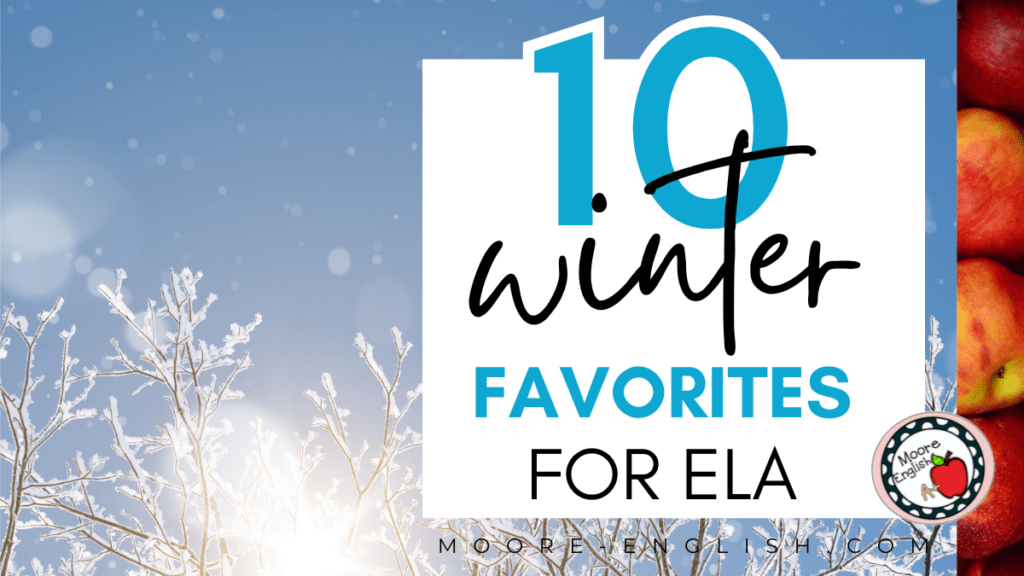Winter is an interesting time in the classroom (as though there are dull moments). Unlike back-to-school or the New Year, winter doesn’t necessarily have a bright-and-shiny element. At a certain point, it’s all slush and the endless slog through third quarter.
And the light at the end of the tunnel? It’s not summer break. Oh, no, it’s standardized testing.
However, there’s a certain allure to winter drudgery because that’s when teachers can really hit their stride with routines and consistency. And doing the same thing well over and over again is key to growth.
To make that winter repetition a little more pleasant, I wanted to share 10 winter favorites for high school ELA.
This post this post may contain affiliate links. Please read the Terms of Use.
Bell Work
When I am feeling drained by winter weather, I always find comfort in routine. And bell work is one of my most-prized classroom routines. Winter is the time of the year when students really start to take ownership of their bell work and of that routine. On one hand, the weather sucks. On the other hand, increasing student self-efficacy is always a win!
To honor the winter season, I like to choose from these Winter and Holiday Visual Writing Prompts. Students enjoy the creativity of visual writing prompts, and I value their flexibility. Teachers can target a variety of skills just by choosing specific images and tailoring the prompts.
Short Works
We all have different experiences and expectations of winter, and our favorite authors are no different. Selecting diverse short works with similar subject matter can help students synthesize across media. As a bonus, “winter” is a fairly tame starting ground for synthesis and can lead students to creative and unexpected connections.
These three texts each offer a unique perspective on “winter.” Of course, what our students learn, is that cold is just a metaphor or symbol for far more interesting topics.
- “Those Winter Sundays” by Robert Hayden is a classic for a reason! Readers can hear the “blueblack cold” in the first stanza. Read it here.
- Similarly, “December” by Jaquira Diaz plays with the idea of cold, but it’s more metaphorical. By naming the month, Diaz is able to play with connotation. These layers lead to meaningful student conversations. Read it here.
- While the speakers in Hayden and Diaz’s speakers are younger, and their foibles are relatable, the man in “To Build a Fire” by Jack London is not. Nevertheless, his struggles in the frigid Klondike engage students by infuriating them. While this is an engaging story for students, it’s long, so I use this abridged and modified version.
Longer Works
Winter is also a favorite time to cozy up with a longer text. These are some favorite options for the classroom.
- First, no title is more perfectly suited to this time of the year than “Winter Dreams.” In this story, F. Scott Fitzgerald captures and criticizes nostalgia, infatuation, and capitalism. I also like to abridge this story for students, so grab my favorite version today!
- As demonstrated by London and Fitzgerald’s narrators, winter weather doesn’t always bring out the best in us. However, sometimes a trip to Antarctica is exactly what we need to learn important lessons about ourselves and our world. Certainly, this is true in “The Rime of the Ancient Mariner” by Samuel Taylor Coleridge. Strictly speaking, this is not a story about winter, but it’s a classic nevertheless. I’ve collected all of Coleridge’s versions of the poem (including all the glosses) in one easy-to-use tool.
- Finally, Pride and Prejudice by Jane Austen has an interesting Christmas connetion for a book that doesn’t really take place during the holidays. Nevertheless, how many Hallmark holiday movies have ties to Austen’s classic? (At least three that I can think of; no shame in my Hallmark game!) Grab my Pride and Prejudice resources today!
Not Just for the New Year
One advantage of winter is the New Year turnover. This is such a great time to revisit classroom norms and goals. However, teachers can always return to norms and goals as needed, so these resources are not winter specific but can and should be revisited all year long!
- First, setting a Word of the Year doesn’t have to be a January activity. It can be a quarterly or monthly activity.
- Second, these Reading Goals bookmarks are a cute and clever way to help students track their reading all year (and all season) long!
- Finally, this free goal sheet is a perfect tool for helping students focus on growth (even in the cold when it seems like nothing is going to grow ever again!).










